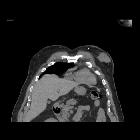Mammakarzinom beim Mann

















Male breast cancer is exceptionally rare and only accounts for less than 0.25% of male malignancies and ~0.5-1% of all breast cancer (both genders). The diagnosis is sometimes delayed due to the patient's hesitancy to seek advice. Workup from a radiological point of view is the same as for women including the use of needle biopsy to confirm the diagnosis.
Epidemiology
The average age of diagnosis of male breast cancer is 60-70 years, which is later than female breast cancer.
Clinical presentation
Most commonly men present with a painless subareolar mass. Male breast cancer is also reported to present at a relatively advanced stage compared with female breast cancer .
Pathology
Histologically, the vast majority are invasive ductal carcinoma (85-90%) or ductal carcinoma in situ.
Risk factors
Recognized risk factors include:
- exposure to ionizing radiation: especially to the chest wall
- cryptorchidism
- testicular injury / infectious orchitis
- increased levels of estradiol
- consider this risk in transgender patients
- Klinefelter syndrome
- liver dysfunction: cirrhosis
- prostate cancer
- family history: ~30% of cases can have a positive family history
- chest trauma
- age
- certain racial groups: may have a comparatively higher incidence
- BRCA2 gene mutation
Please note gynecomastia is not a risk factor per se.
Location
- can occur anywhere within the breast but favors the subareolar area or the upper outer quadrant
- favors a slightly eccentric location in relative to the nipple
Genetics
The genetic predisposition for breast cancer can be inherited from both mother and father. First line family history includes both genders.
Radiographic features
Mammography
Typically seen as a subareolar mass (often round, oval, or lobulated) and at times can be masked by the presence of concurrent gynecomastia . Calcifications tend to be fewer in number and coarser than female breast cancer .
Treatment and prognosis
The overall prognosis tends to be worse than for female breast cancer which may due to men presenting at later stages (i.e. when the mass has grown to a palpable level).
Siehe auch:
- Leberzirrhose
- Kryptorchismus
- Adenokarzinom der Prostata
- Gynäkomastie
- duktales in situ Karzinom der Mamma
- invasives duktales Karzinom
- Klinefelter-Syndrom
- male breast disease
- Neoplasien der Mamma
- mammarian metastases from prostate cancer
und weiter:

 Assoziationen und Differentialdiagnosen zu Mammakarzinom beim Mann:
Assoziationen und Differentialdiagnosen zu Mammakarzinom beim Mann:






